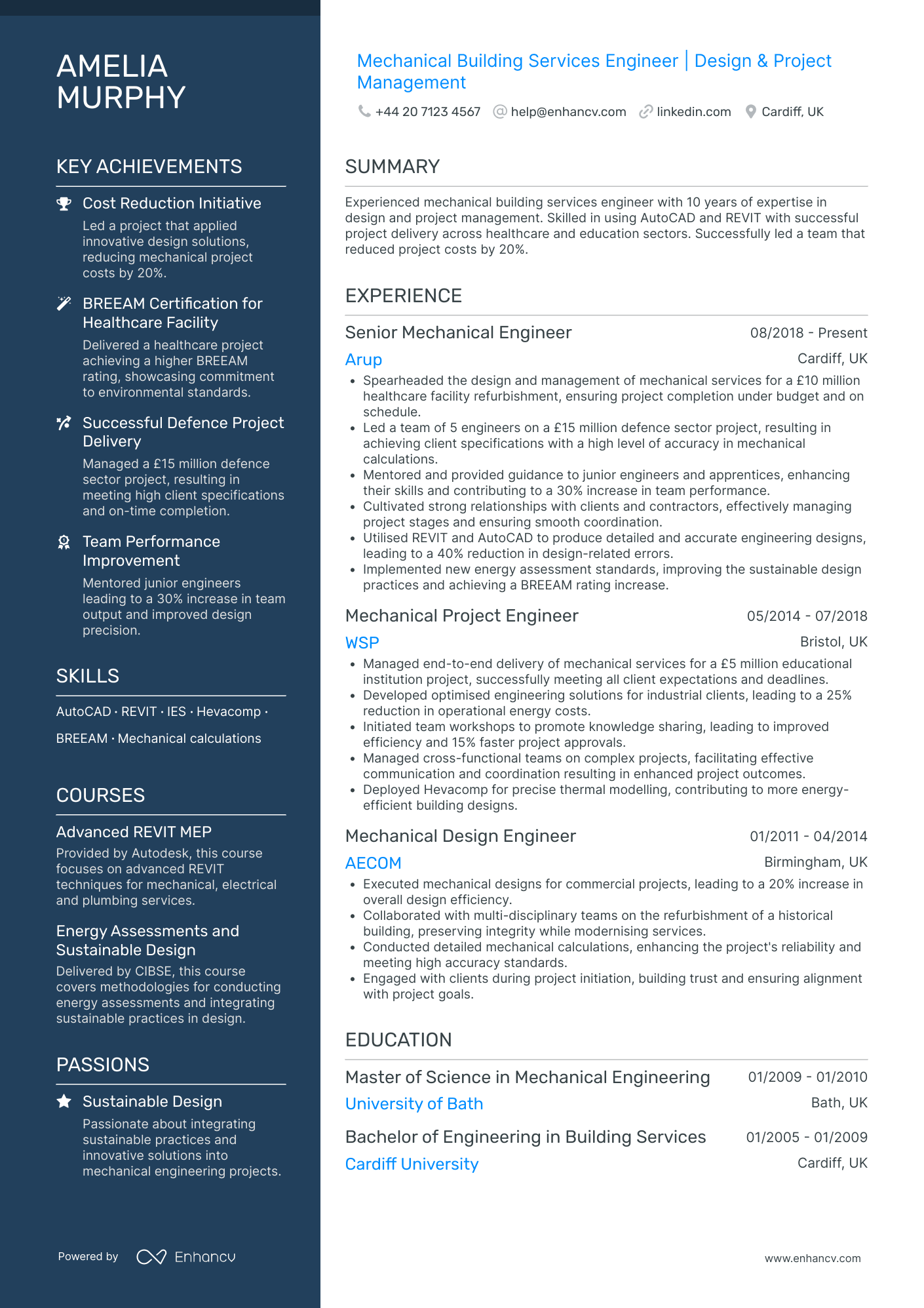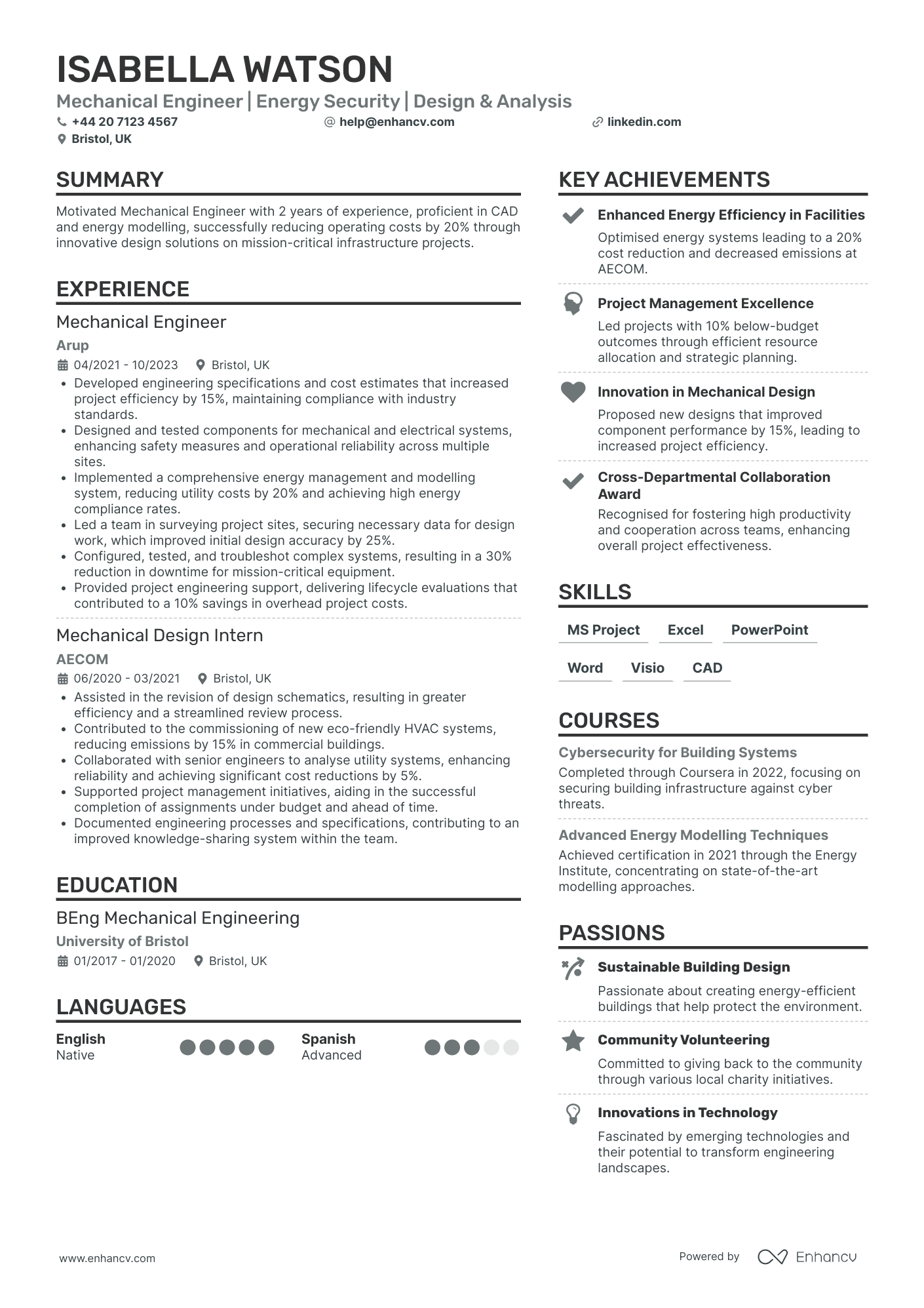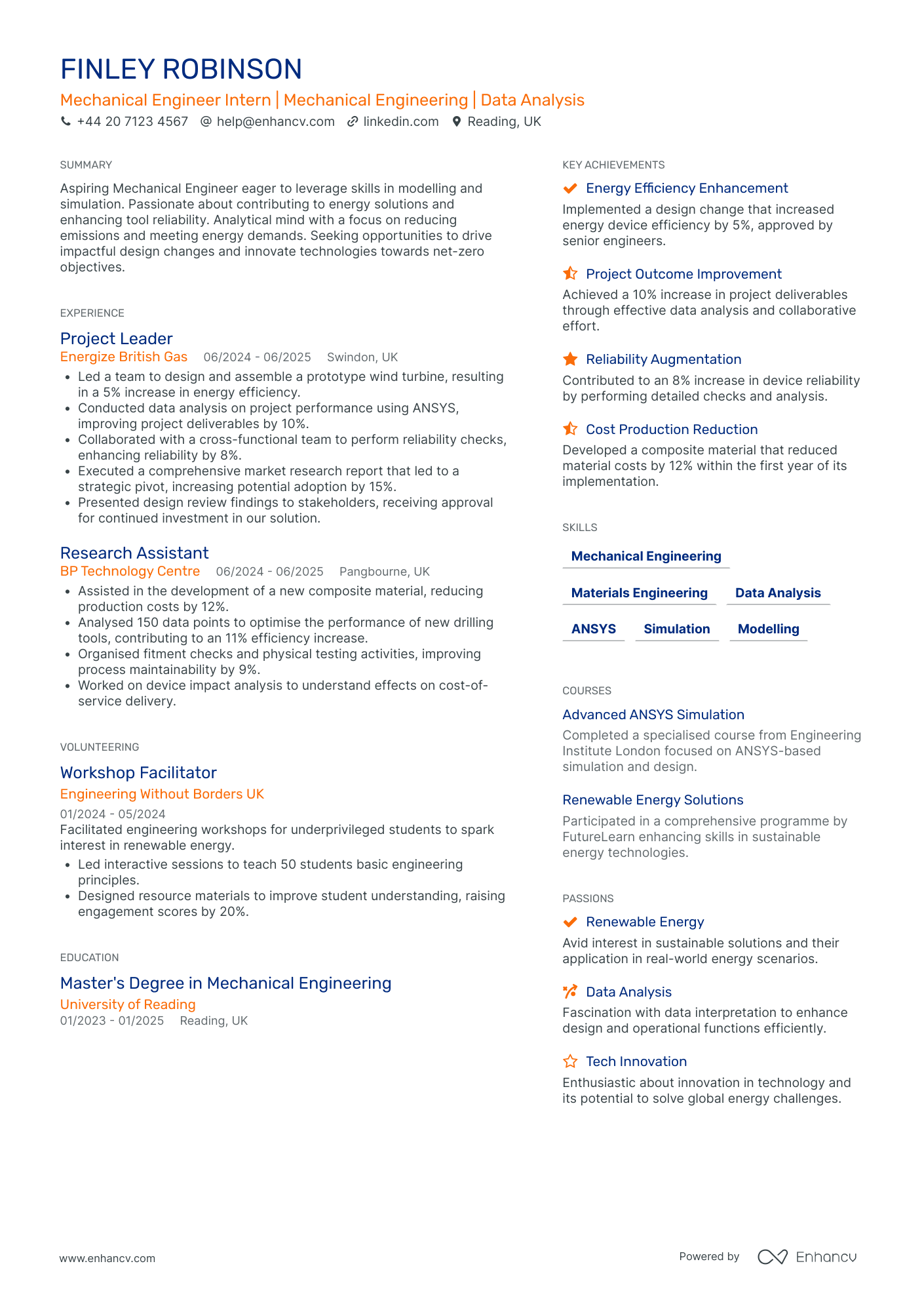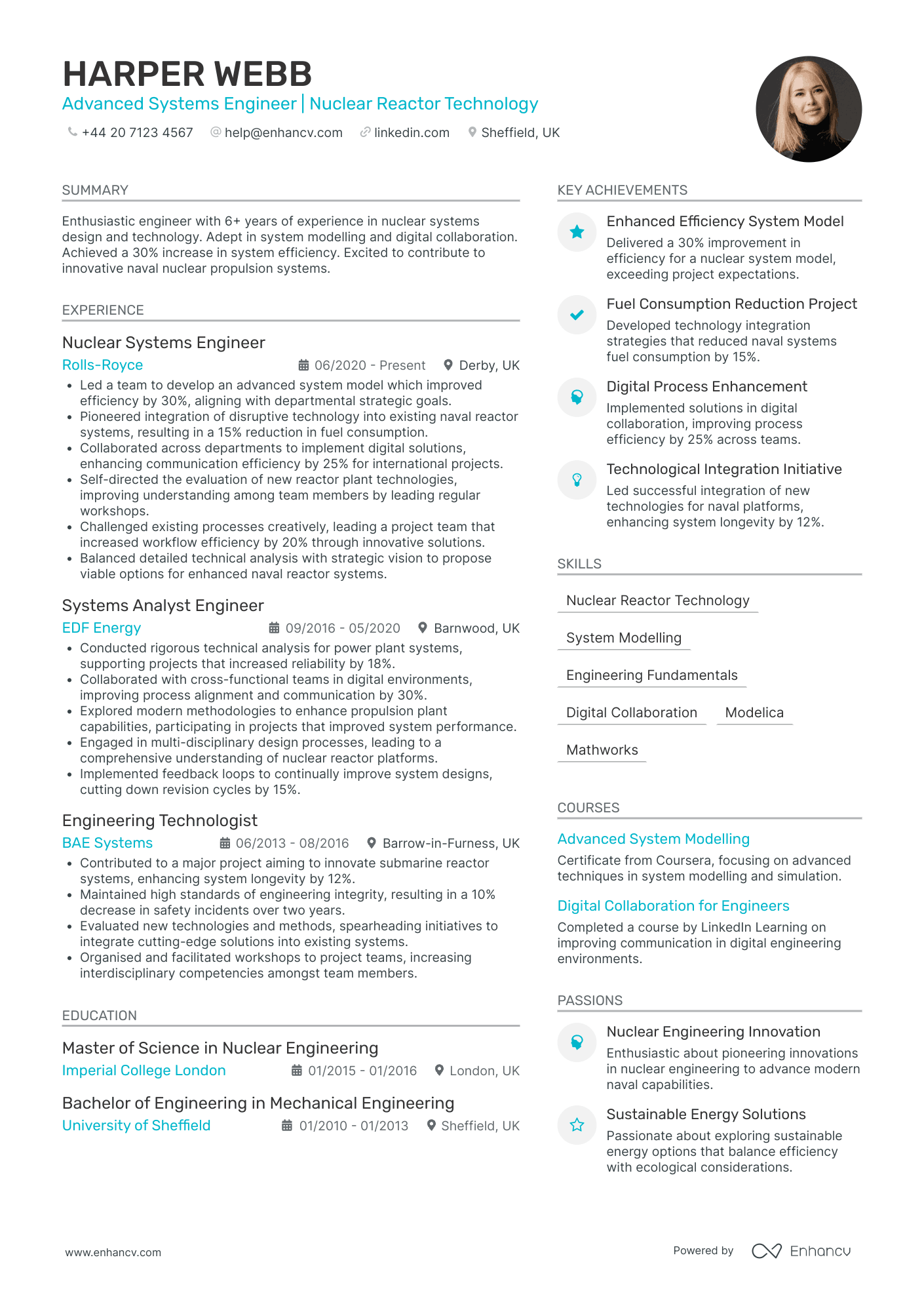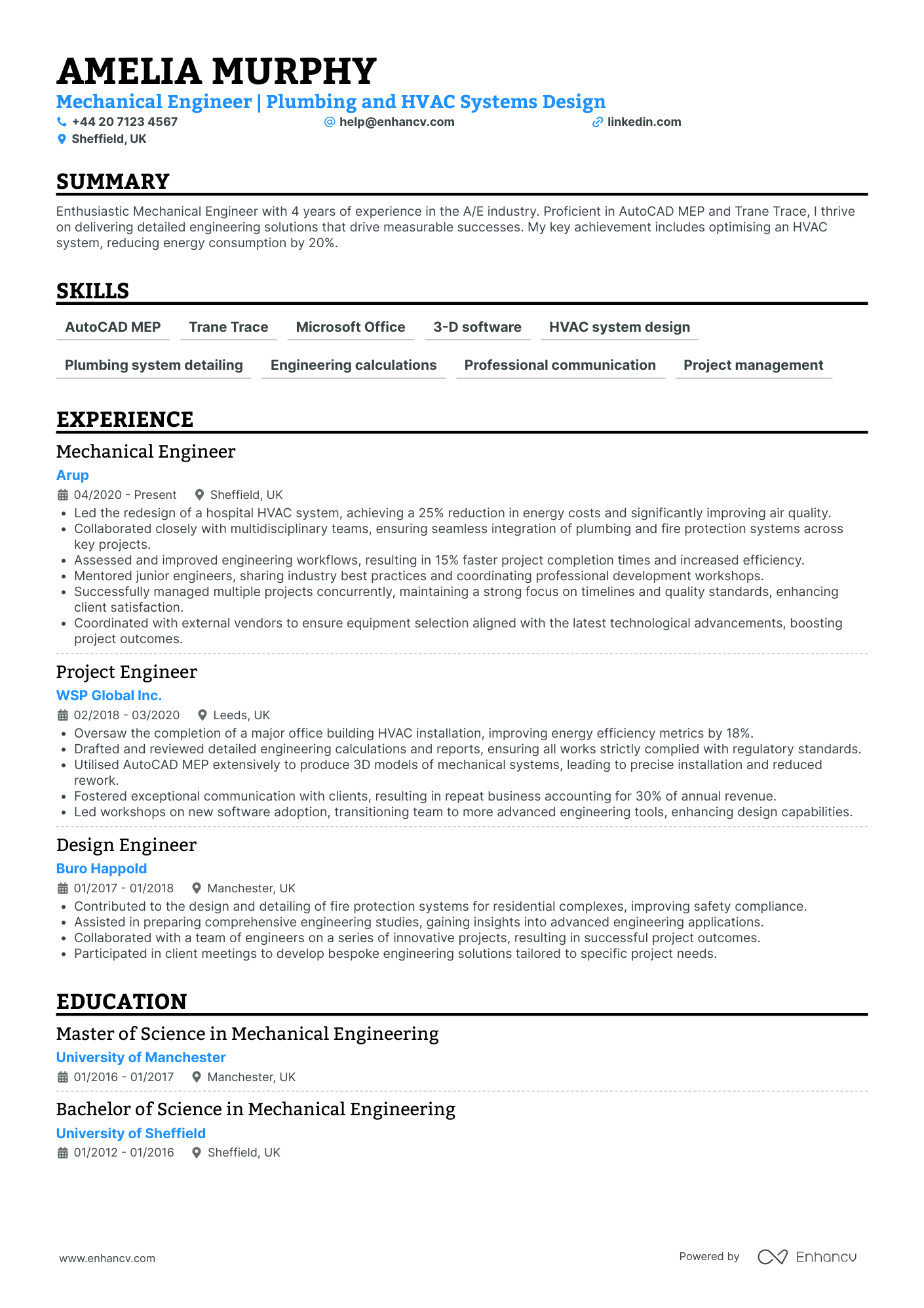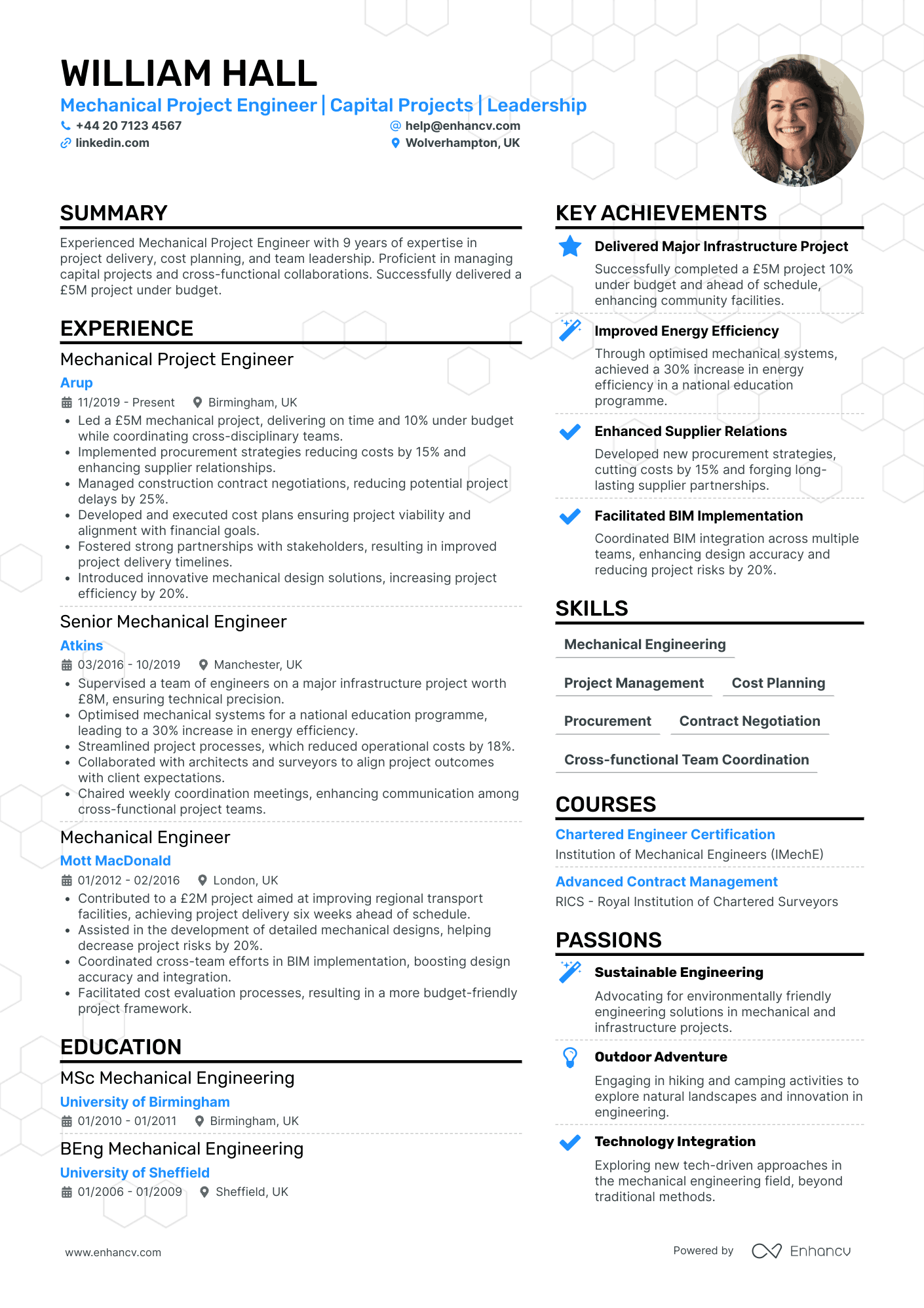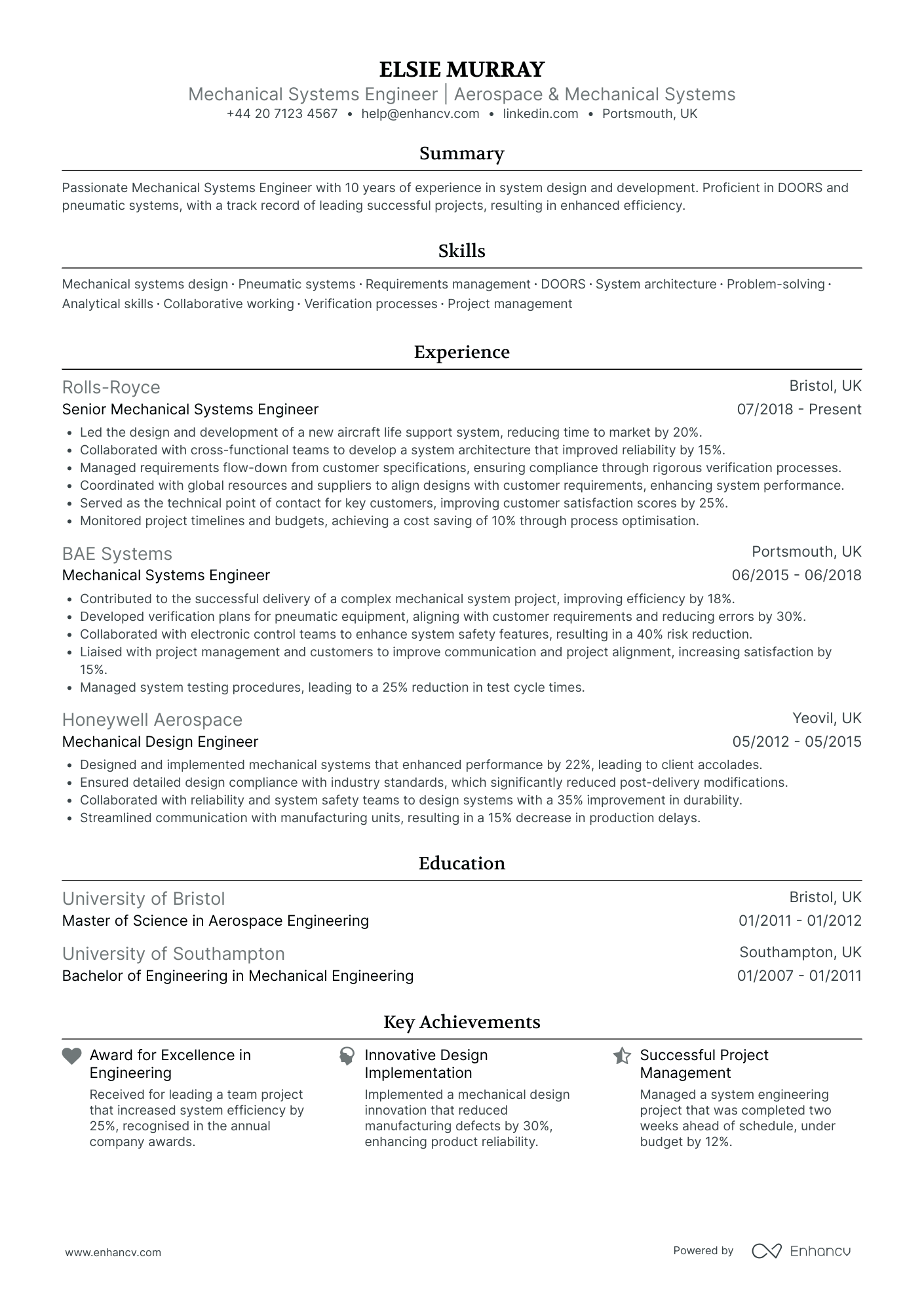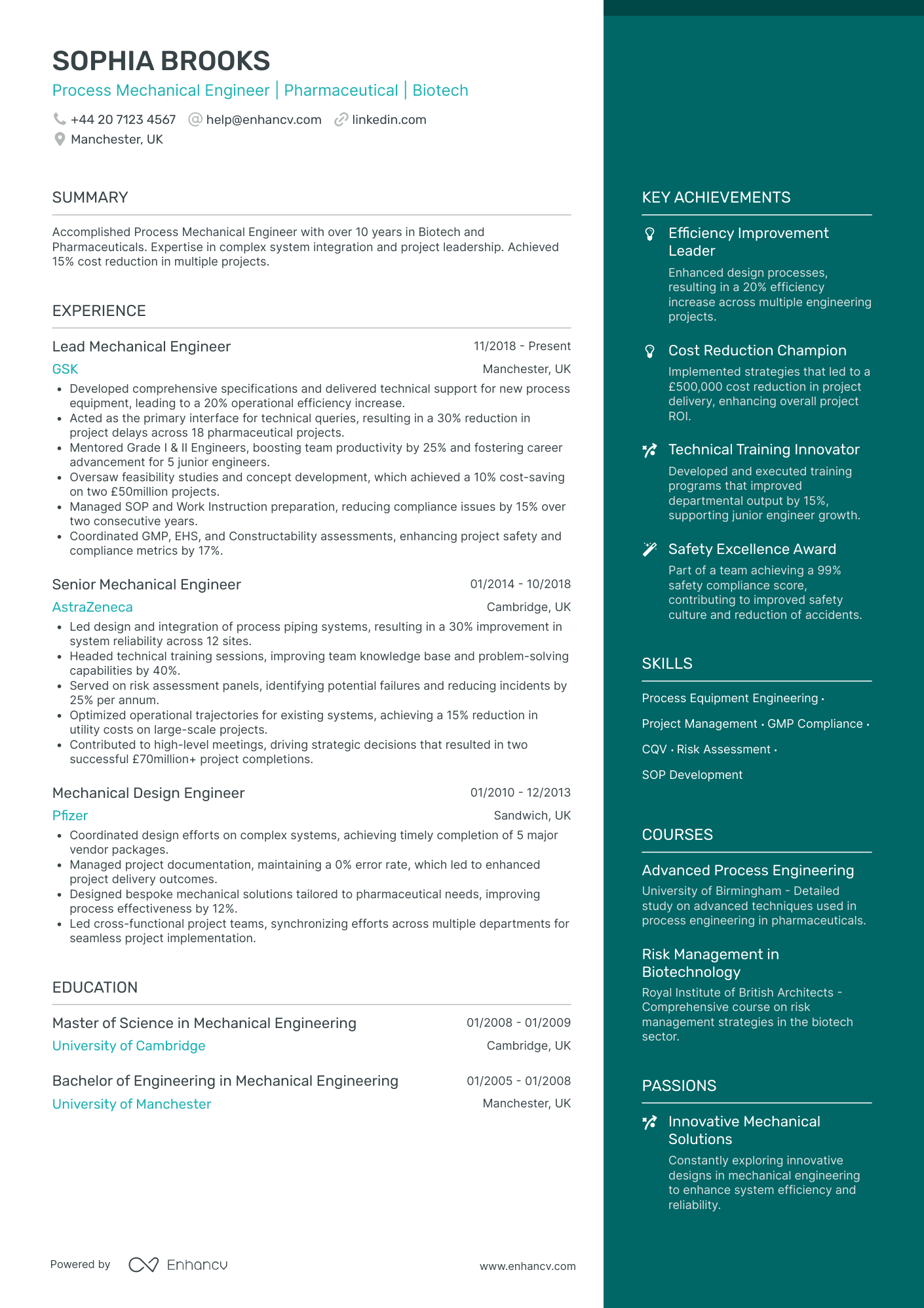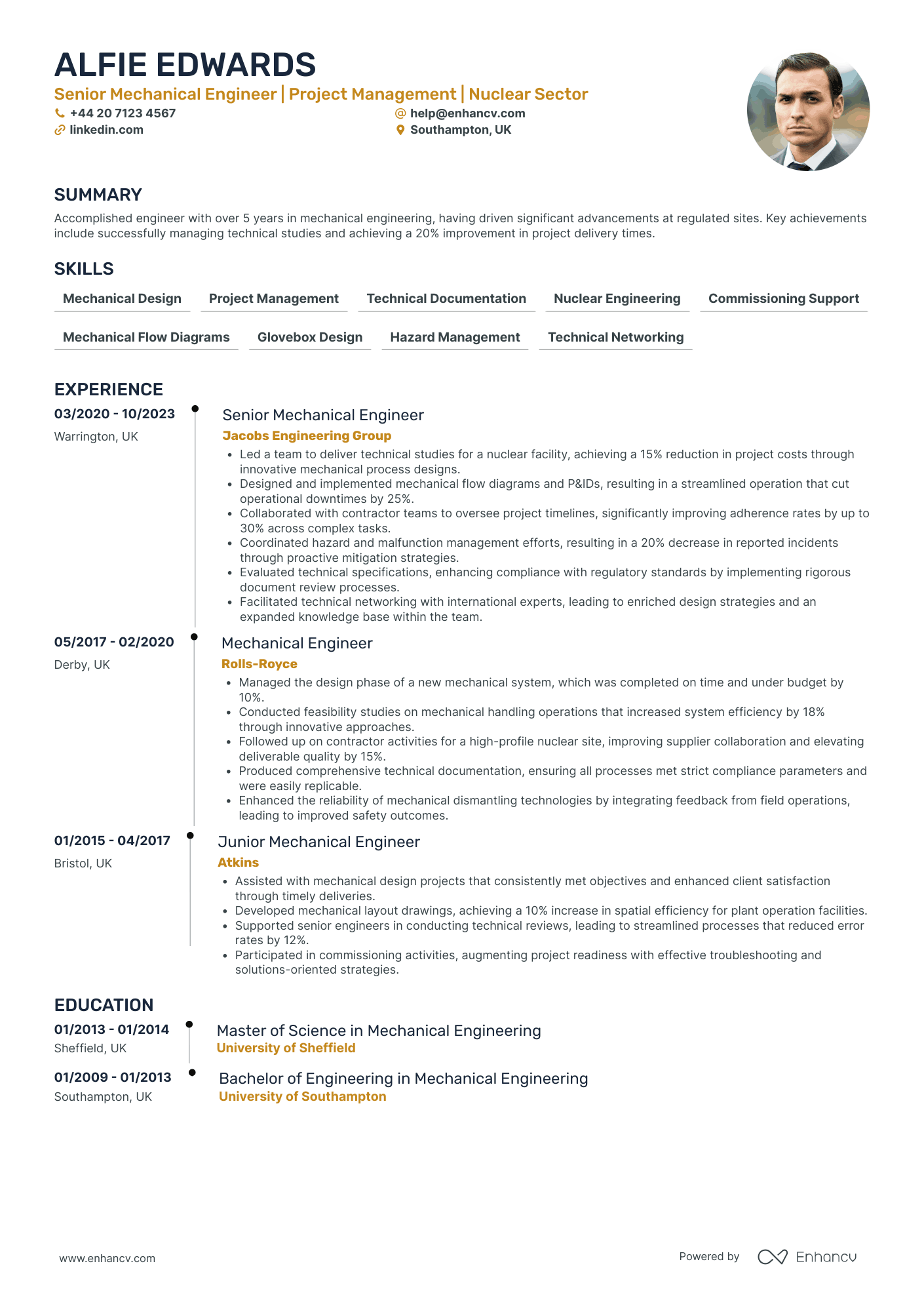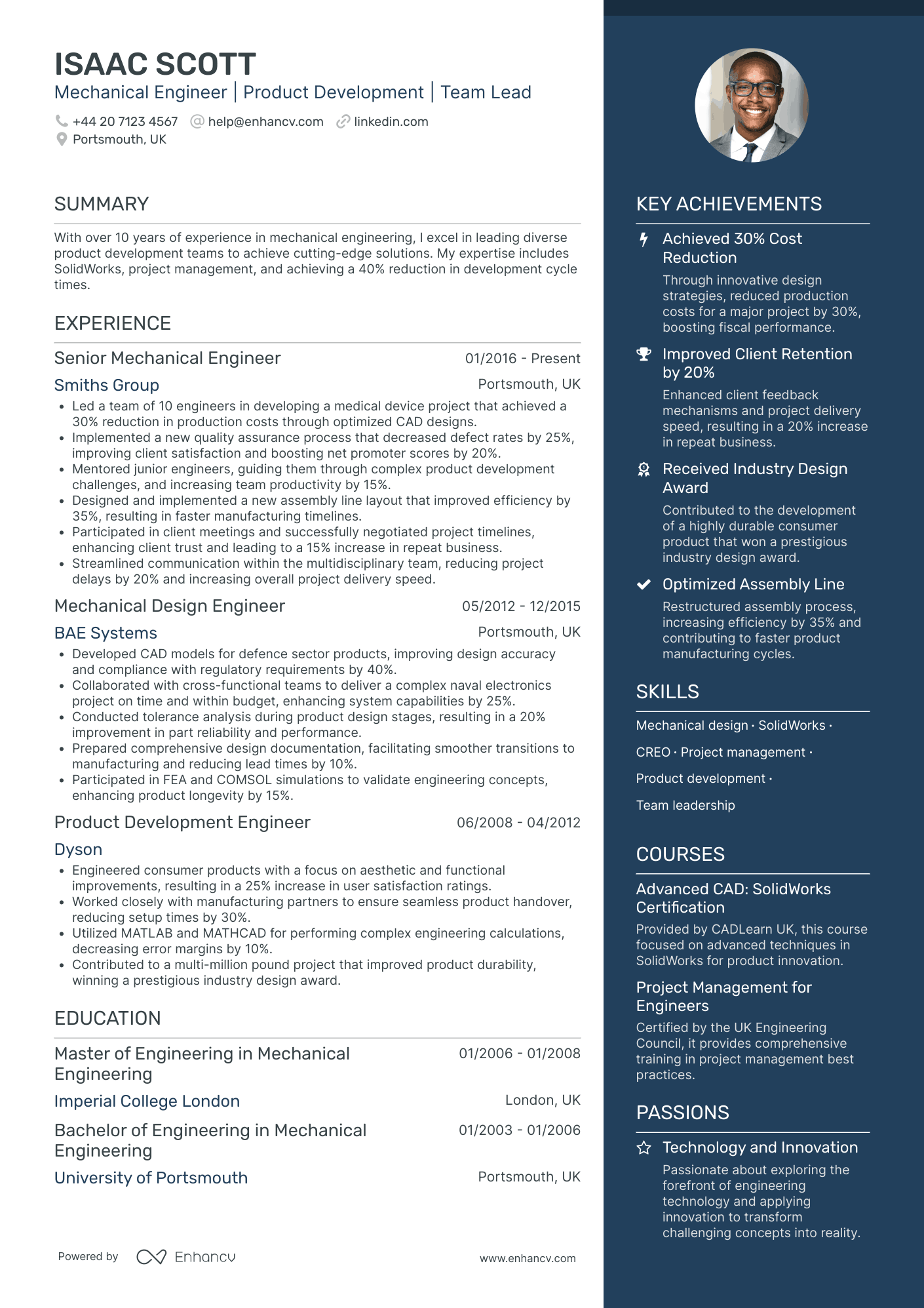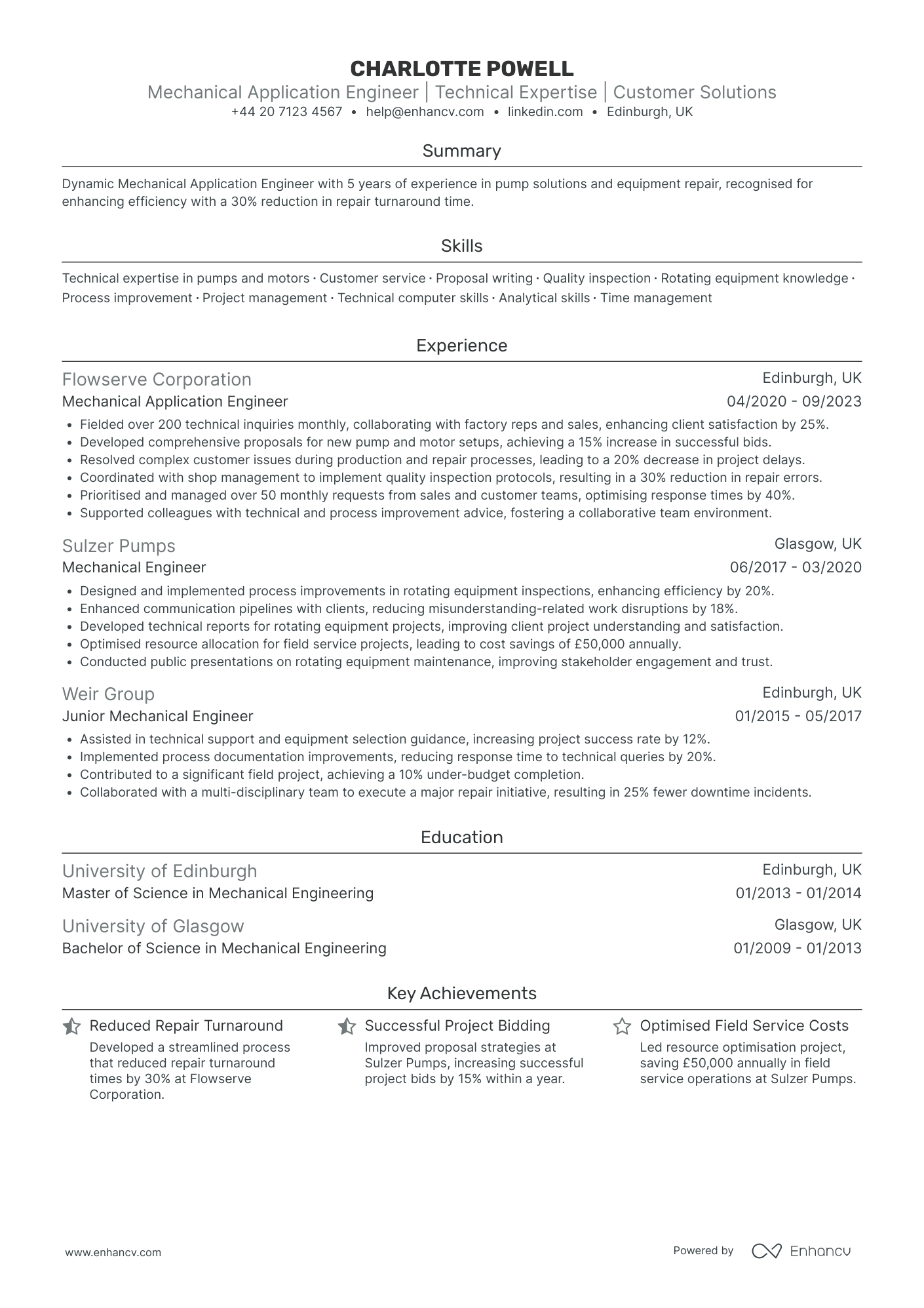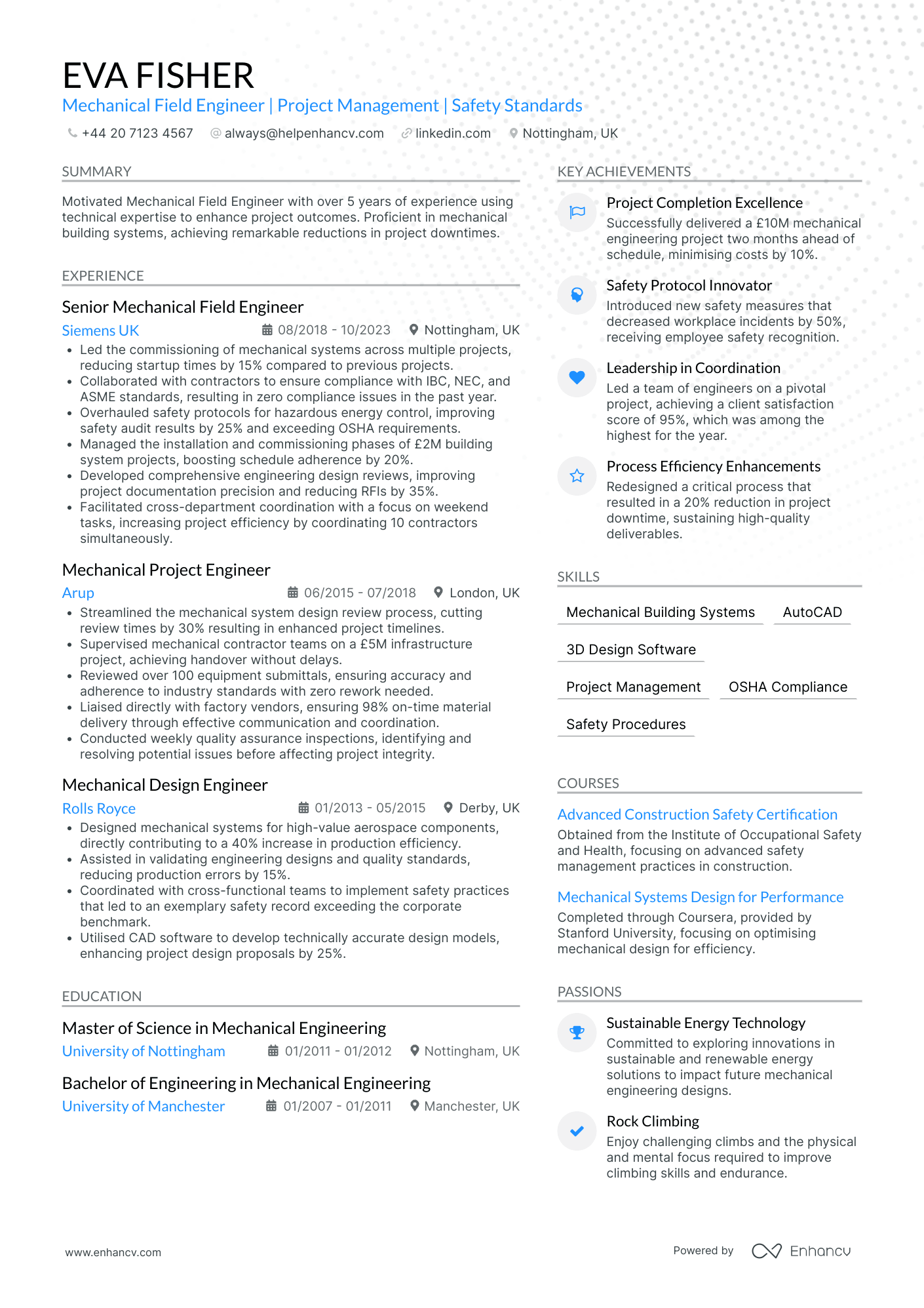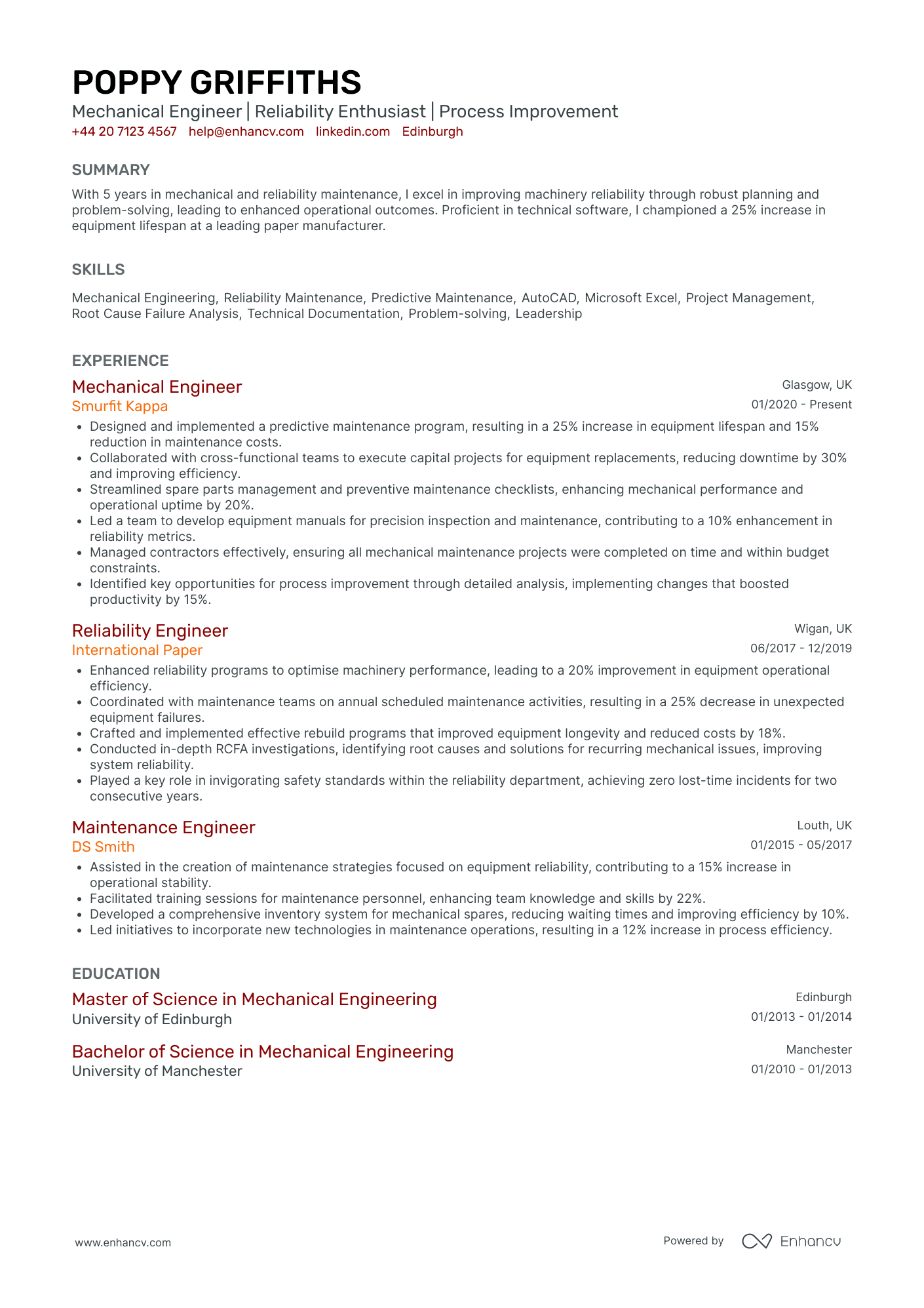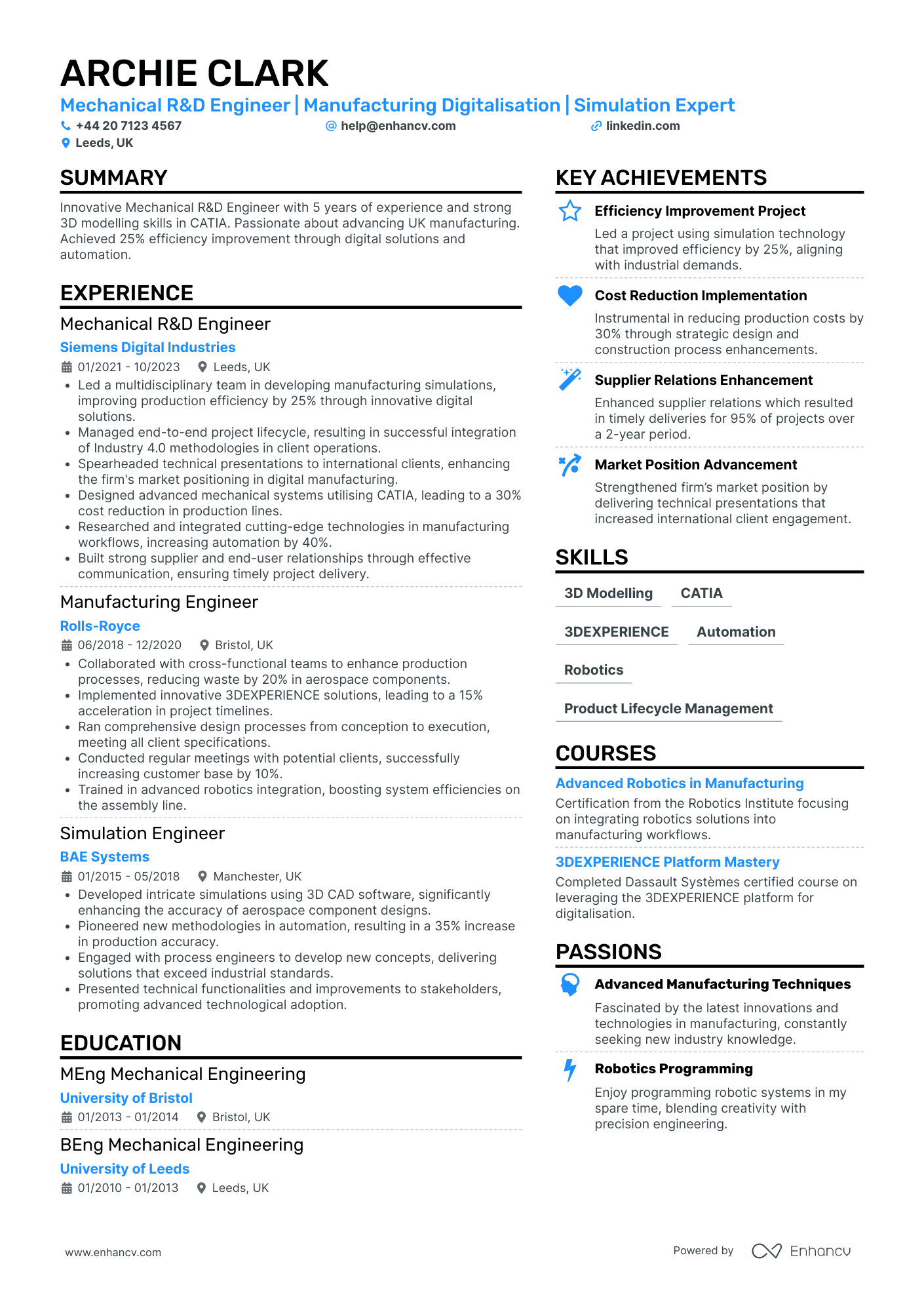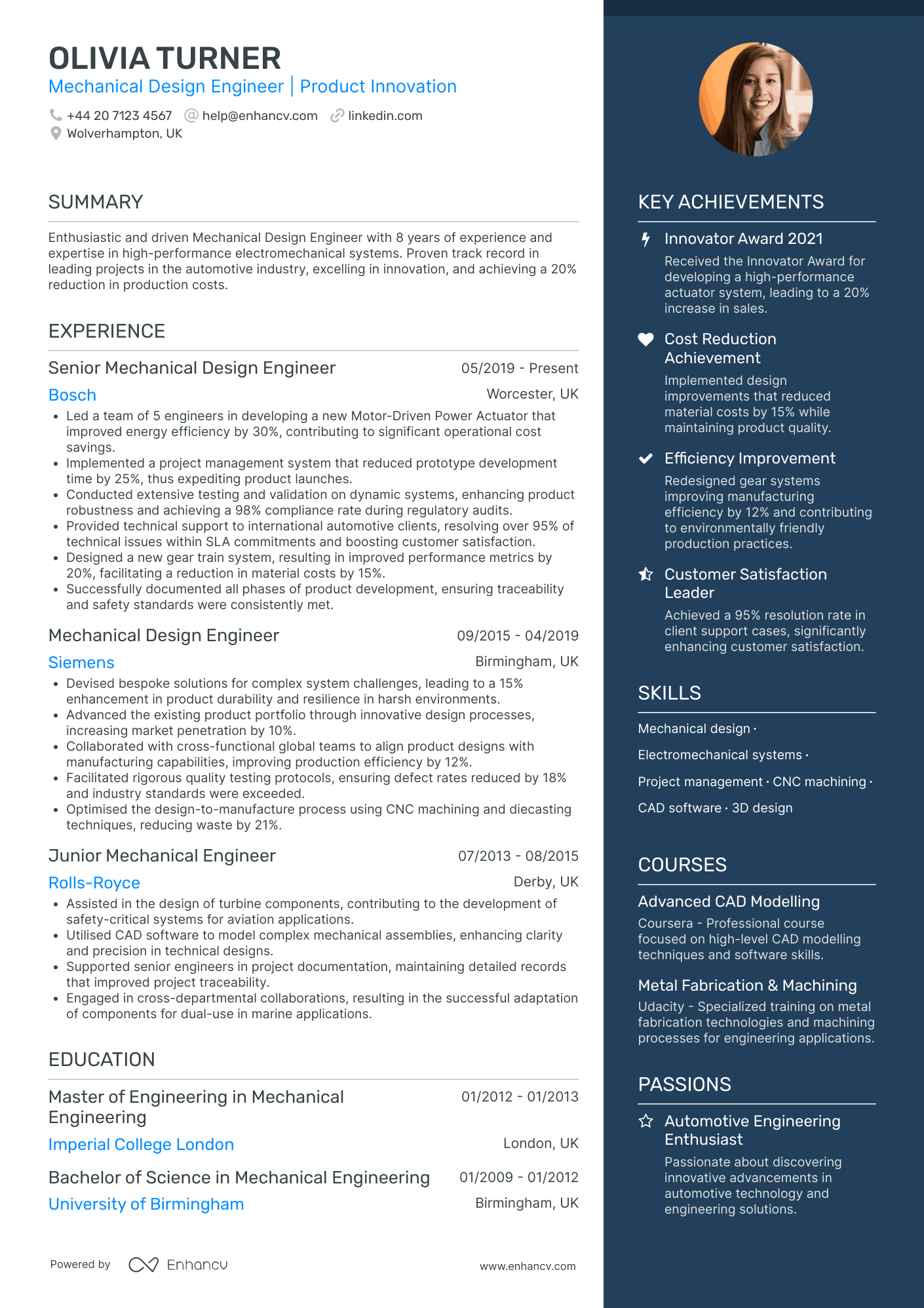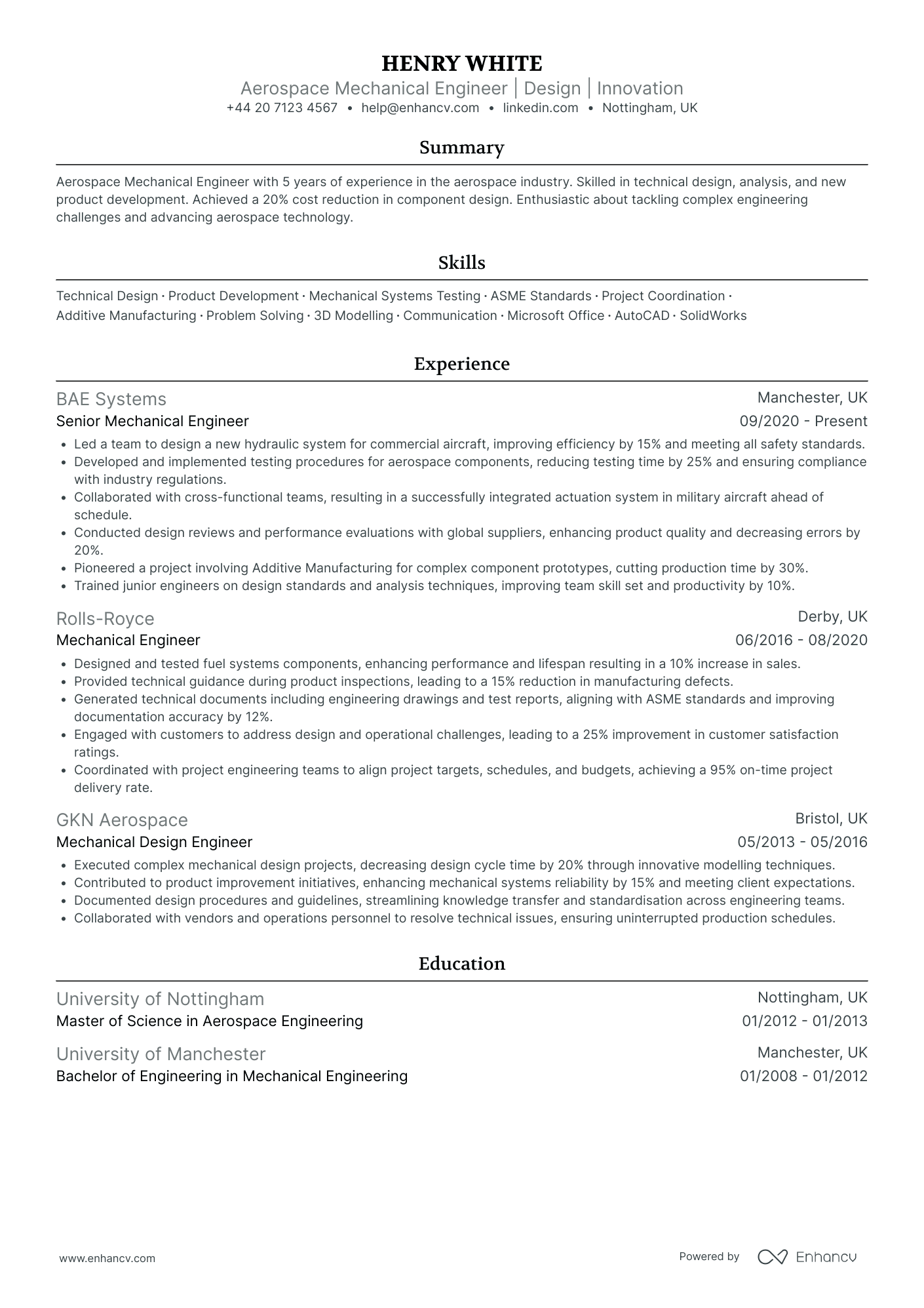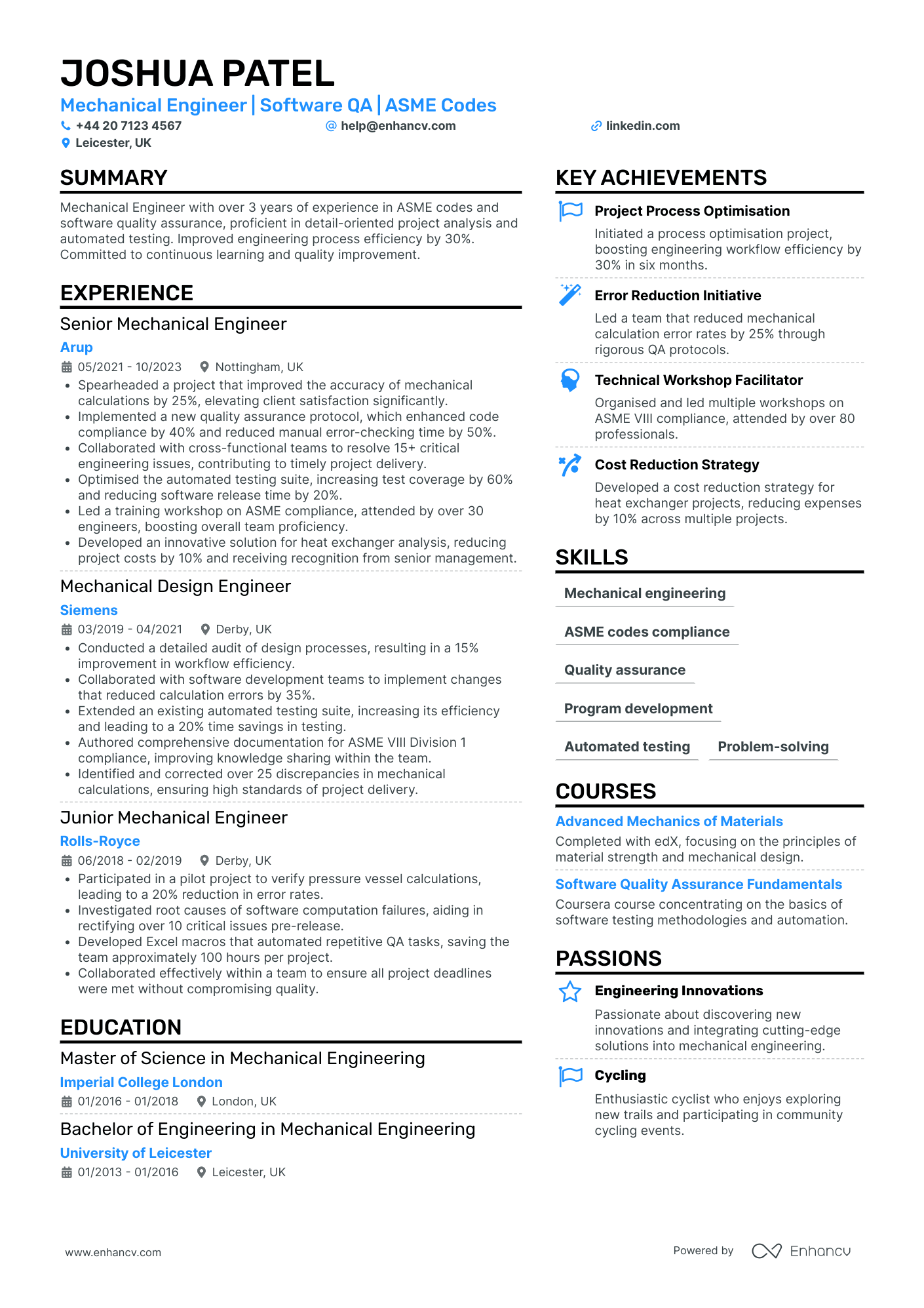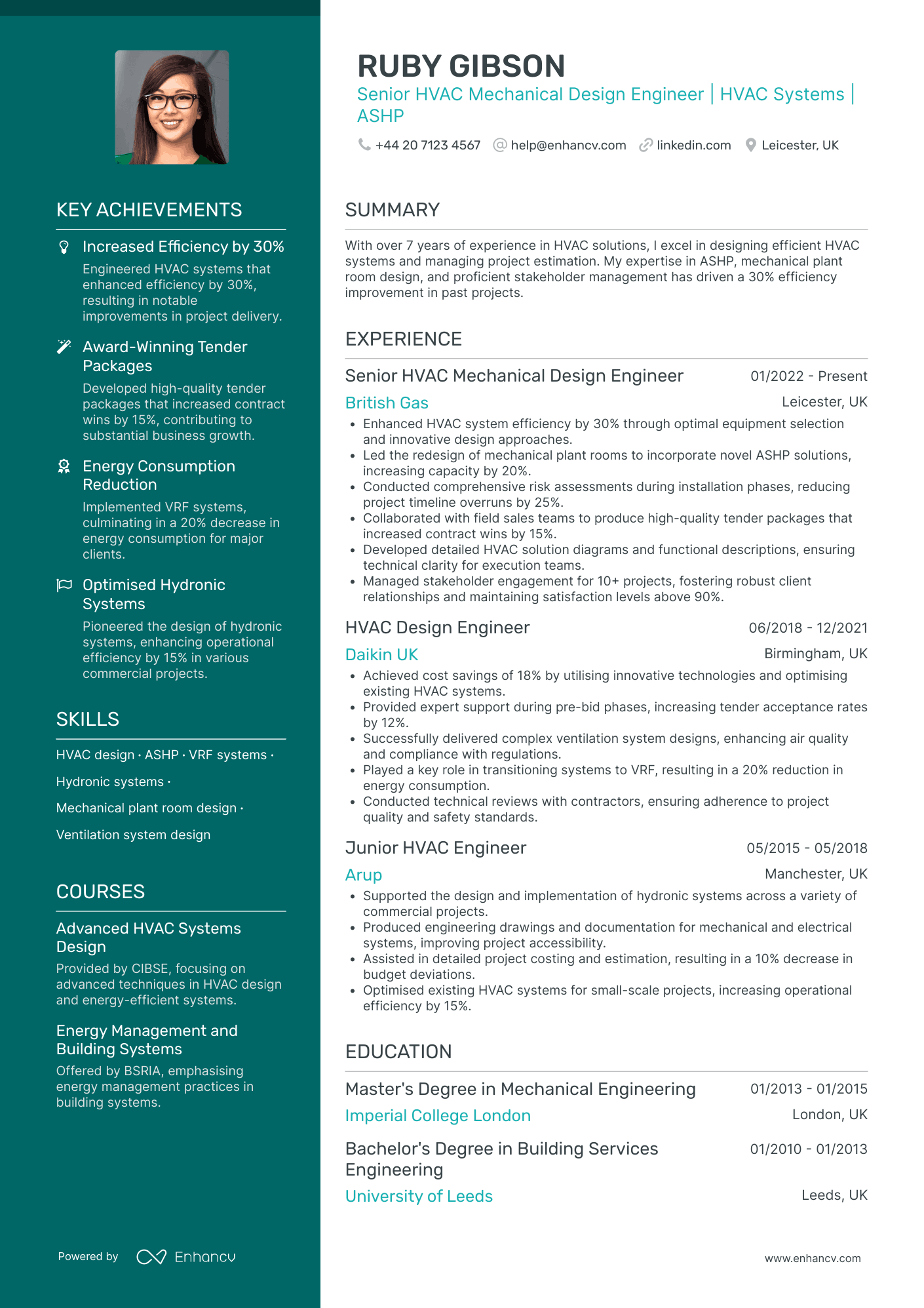Crafting your CV to stand out amongst a sea of applicants can be a daunting challenge for a mechanical engineer. Our guide offers tailored advice and strategies to highlight your unique skills and experience, ensuring your application grabs the attention of potential employers.
- Applying best practices from real-world examples to ensure your profile always meets recruiters' expectations;
- What to include in your work experience section, apart from your past roles and responsibilities?
- Why are both hard and soft skills important for your application?
- How do you need to format your CV to pass the Applicant Tracker Software (ATS) assessment?
If you're writing your CV for a niche mechanical engineer role, make sure to get some inspiration from professionals:
- Project Engineer CV Example
- Structural Engineer CV Example
- Aerospace Engineering CV Example
- Construction CV Example
- Construction Manager CV Example
- Infrastructure Engineer CV Example
- Electrical Engineering CV Example
- Systems Engineer CV Example
- Chemical Engineer CV Example
- Construction Worker CV Example
CV examples for mechanical engineer
By Experience
Principal Mechanical Engineer
- Structured clarity and concise content presentation - The CV presents information in a structured, easy-to-read manner that highlights key qualifications and accomplishments. Each section, from the professional summary to education and skills, is succinctly presented, ensuring the reader can quickly access the most relevant information.
- Impressive career trajectory and growth - Amelia Murphy's career path is illustrative of a consistently advancing professional. Starting from a Mechanical Design Engineer to a Senior Mechanical Engineer, her promotions are mirrored by an increasing scale of projects and responsibilities, showing a clear trajectory of growth and expertise within the industry.
- Unique industry-specific tools and methodologies - The CV details specific engineering tools such as AutoCAD, REVIT, IES, and Hevacomp, demonstrating Amelia's proficiency with essential software in mechanical building services. The mention of energy assessment methodologies and standards like BREEAM highlights her technical depth and industry-specific knowledge.
Junior Mechanical Engineer
- Content Presentation and Structure - Isabella Watson's CV is structured with precision, enhancing readability through well-organized sections. Each section is clear and concise, allowing for easy navigation between her professional experience, education, skills, and achievements. This systematic approach ensures that key information is accessible and immediately impactful to potential employers.
- Career Trajectory and Growth - Watson’s CV reflects a progressive career in mechanical engineering, showcasing a steady climb from an intern position at AECOM to a mechanical engineer role at Arup. This trajectory highlights her consistent professional advancement within the industry, underscored by her increasing responsibilities and impact in engineering design and project management.
- Technical Proficiency and Industry-Specific Expertise - Isabella stands out with her expertise in CAD, energy modeling, and complex system configuration. Her CV emphasizes her proficiency in industry-specific tools and methodologies, which are crucial for roles in mechanical engineering and energy security. This technical depth is complemented by certifications in cybersecurity and advanced energy modeling, underscoring her commitment to staying ahead in her field.
Mechanical Engineer Intern
- Diverse Technical Toolkit - Finley Robinson's CV effectively demonstrates proficiency in industry-relevant tools like ANSYS and showcases deep technical knowledge in areas like simulation and data analysis, which are vital for a mechanical engineering role focused on energy solutions.
- Strategic Leadership and Impact - Through roles such as Project Leader for Energize British Gas, Finley has shown leadership qualities and strategic foresight by leading cross-functional teams to design innovative prototypes and execute pivotal market research, significantly improving project adoption rates and energy efficiency.
- Adaptability and Cross-Functional Collaboration - The CV illustrates Finley's adaptability and ability to work across various functions, exemplified by experiences like enhancing material performance at BP Technology Centre. Their role as a Research Assistant involved collaborating on material development and optimizing drilling tools, emphasizing their capability to drive cross-domain innovations.
Entry-Level Mechanical Engineer
- Structured progression with targeted expertise - The CV effectively details a career trajectory that progresses through increasingly responsible roles in high-impact engineering contexts. Harper's advancement from an Engineering Technologist to an Advanced Systems Engineer portrays a focused path within nuclear reactor technology, underscoring their commitment to this specialized field.
- Emphasis on impactful achievements and innovation - Throughout the CV, Harper highlights specific and quantifiable accomplishments demonstrating their ability to implement efficiency improvements and cost reductions. For example, the integration of disruptive technology led to a notable 15% reduction in fuel consumption, illustrating not just technical competence but also the capacity to drive material improvements in operational efficiency.
- Comprehensive use of industry-specific tools and methods - Harper’s proficiency in sophisticated tools such as Modelica, Mathworks, and Ansys Twinbuilder reflects a deep technical skill set tailored to nuclear reactor technology. This knowledge base, combined with hands-on experience in pioneering modern system modeling, signifies their preparedness to handle complex engineering challenges within the nuclear sector.
Mechanical Engineer in Training
- Structured Presentation and Clarity - The CV is well-organized with clear sections that make it easy to navigate. Each section is concise, yet comprehensive, ensuring key information such as skills, experiences, and achievements are highlighted without overwhelming the reader. The use of distinct sections like 'Experience', 'Education', and 'Achievements' provides a structured overview of Amelia's professional journey.
- Progressive Career Trajectory - Amelia's career path demonstrates significant growth, moving from a Design Engineer to a Mechanical Engineer role. This progression indicates her expanding responsibilities and expertise in plumbing and HVAC systems design. Her career advancements are indicative of her evolving technical depth and leadership qualities, which are critical for a mechanical engineer's success.
- Technological Proficiency with Industry-Specific Tools - Amelia's CV highlights her proficiency with crucial tools such as AutoCAD MEP and Trane Trace, pivotal for HVAC and plumbing system design. This demonstrates a deep understanding of industry-specific software, underpinning her ability to deliver engineering solutions efficiently. Her certification in AutoCAD MEP further reinforces her technical proficiency, relevant to the mechanical engineering industry.
By Role
Mechanical Project Engineer
- Structured for clarity and impact - The CV is meticulously organized, with each section clearly labeled and logically flowing from one to the next. This clarity makes it easy to follow the candidate's career journey and quickly understand their qualifications, setting a strong foundation for emphasizing their suitability for the role.
- Impressive career trajectory - The CV showcases a robust career path with evident growth and progressive responsibilities in project management. It tracks a linear progression from a junior role to a senior leadership position, highlighting promotions that reflect the candidate's expanding competencies and dedication to their profession.
- Emphasis on cross-functional collaboration - One standout element is the candidate’s proven adaptability and experience in cross-functional roles. The CV details experiences where they collaborated with IT, marketing, and sales teams, effectively bridging different departments to drive cohesive project outcomes and foster an integrated work environment.
Mechanical Systems Engineer
- Clear and structured progression - Elsie Murray's CV presents a well-defined career path, showcasing her progression from a Mechanical Design Engineer to a Senior Mechanical Systems Engineer at reputable companies in the aerospace industry. This clarity emphasizes her growing expertise and successful career trajectory.
- In-depth technical expertise - The CV highlights Murray’s proficiency in industry-specific tools like DOORS for requirements management and her deep understanding of pneumatic and mechanical systems. This technical depth is crucial for roles in aerospace and mechanical engineering.
- Leadership in cross-functional collaborations - Murray’s experience includes significant leadership roles where she drove cross-functional projects and collaborated with various teams to enhance system reliability and efficiency. Her ability to lead diverse teams and communicate effectively reflects her strong soft skills and adaptability within complex engineering environments.
Mechanical Process Engineer
- Clear Structure and Comprehensive Presentation - Sophia Brooks' CV is structured effectively, providing clarity through well-organized content. Each section is distinct and concisely presented, highlighting critical areas such as experience, education, skills, and achievements without overwhelming the reader with unnecessary details. This clarity ensures that hiring managers can quickly assess her qualifications and suitability for roles in pharmaceutical and biotech engineering.
- Consistent Career Growth and Industry Commitment - The CV reflects a clear trajectory of career advancement, from Mechanical Design Engineer at Pfizer to Lead Mechanical Engineer at GSK. Each role demonstrates a logical progression in responsibility and expertise, underscoring a solid commitment to the pharmaceutical and biotech industries. This progression not only showcases her professional development but also her capacity to adapt and excel in an evolving industry.
- Quantifiable Achievements and Impact - The inclusion of quantifiable impacts in Sophia's achievements, such as achieving a 20% operational efficiency increase and reducing costs by £500,000, adds significant value to her profile. These metrics provide concrete evidence of her capabilities and contributions to project success, reinforcing her ability to deliver substantial business results in engineering roles.
Senior Mechanical Engineer
- Strategic career growth highlighted by leadership roles - The CV effectively outlines a clear trajectory of growth where the candidate has progressively taken on more senior roles, indicating not just experience but drive and potential. Their journey from entry-level engineer to project leader in just seven years showcases strong leadership skills and a proactive approach to career development.
- Integration of cutting-edge technologies - The candidate's experience section reflects expertise in using advanced tools and methodologies, particular to the tech industry, such as machine learning models, blockchain, and cloud computing. Their competence in implementing these technologies has facilitated innovation and driven key projects within their company.
- Interdepartmental collaboration and adaptability - The CV emphasizes the candidate’s adaptability by documenting successful collaborations across departments, such as working with marketing, design, and data analytics teams. This cross-functional experience demonstrates their ability to integrate diverse perspectives and skills to achieve comprehensive project goals and adapt to varied business needs.
Mechanical Engineer Consultant
- Structured and Concise Presentation - The CV is well-organized, presenting each section with clarity and relevance. Key details are concisely listed, ensuring the reader can easily follow the candidate’s career path and achievements without overwhelming them with information.
- Impressive Career Growth and Industry Experience - Isaac Scott's career trajectory illustrates steady growth from a Product Development Engineer at Dyson to a Senior Mechanical Engineer at Smiths Group. This progress reflects an accumulation of experience and leadership capabilities, underscoring his expertise in the mechanical engineering sector.
- Proficiency in Advanced Industry Tools - The CV highlights technical depth, with skills in sophisticated tools such as SolidWorks, MATLAB, and CREO. This demonstrates Isaac's capability in handling complex engineering tasks and his familiarity with industry-standard methodologies, setting him apart in the field.
Mechanical Application Engineer
- Structured and Clear Presentation - The CV excels in presenting information clearly, with well-organized sections for professional experience, education, and skills. This structured approach aids in quickly identifying key qualifications and accomplishments relevant to the role of Mechanical Application Engineer.
- Consistent Career Growth - Charlotte Powell's career trajectory shows a consistent upward movement in the mechanical engineering industry. Starting as a Junior Mechanical Engineer and progressing to a Mechanical Application Engineer, she has steadily advanced, taking on more responsibility and complex projects.
- Industry-Specific Technical Expertise - The CV highlights unique skills such as expertise in rotating equipment and pump systems, which are crucial for her role. Her experience with developing comprehensive proposals and the technical depth in process improvement projects add significant value to her profile.
Mechanical Field Engineer
- Clear and structured presentation - The CV functions as a well-organized document, exhibiting clear section headers and bullet points that concisely present Eva Fisher's extensive experience and qualifications. This not only makes the content easy to navigate but also allows key achievements and skills to stand out, facilitating quick comprehension by the reader.
- Significant career growth and leadership - Eva's career trajectory reflects consistent advancement from a Mechanical Design Engineer to a Senior Mechanical Field Engineer, emphasizing her growth in responsibility and leadership. Her promotions signify recognition of her competence, while the sectors represented—air transportation, engineering consultancy, and field equipment—showcase her ability to adapt within the mechanical engineering realm.
- Strong focus on safety and compliance - The CV integrates industry-specific elements like adherence to OSHA standards, utilization of IBC, NEC, and ASME codes, and implementation of advanced safety protocols. Such details not only underline her technical depth but also highlight her commitment to safety and regulatory compliance, essential for roles in mechanical engineering and fieldwork.
Mechanical Reliability Engineer
- Structured Career Progression - Poppy Griffiths’ CV demonstrates a clear upward trajectory in her field, moving from Maintenance Engineer to Mechanical Engineer, and then to Reliability Engineer, showcasing her growth and experience in the mechanical engineering and reliability sector.
- Technical Depth and Methodologies - The inclusion of specific industry tools such as AutoCAD and methodologies like Root Cause Failure Analysis (RCFA) highlights her technical proficiency and specialized knowledge in reliability maintenance and process improvement.
- Cross-Functional Leadership and Problem-Solving - Poppy's capability to lead cross-functional teams, effectively manage contractors, and spearhead training initiatives underscore her leadership and adaptability. These attributes, combined with her problem-solving prowess, make her a strong candidate for roles requiring leadership and operational excellence.
Mechanical Research Engineer
- Structured and clear presentation of content - The CV is very well-organized, starting with personal details and a concise summary that sets a strong foundation for the rest of the document. Each section is clearly defined, with highlights of the candidate's job roles and responsibilities being laid out in a bullet-point format, enabling the reader to quickly grasp the essential points.
- Illustrates a dynamic career trajectory - Archie’s career path shows consistent professional growth and development within the mechanical and manufacturing industries. Each role advances in responsibility, from Simulation Engineer to Mechanical R&D Engineer, reflecting a trajectory of increasing technical and leadership acumen in prestigious companies like Siemens and Rolls-Royce.
- Demonstrates notable industry-specific expertise - The CV highlights Archie’s proficiency in industry-relevant tools like CATIA and 3DEXPERIENCE, alongside methodologies such as Industry 4.0, which are critical in the field of manufacturing digitalization. These technical skills are paired with evidence of significant impact, such as a 25% improvement in efficiency through simulation and automation.
Automotive Mechanical Engineer
- Structured and Comprehensive Layout - The CV stands out with a well-organized structure that allows easy navigation through various sections. Each section, from education to experience and skills, is clearly delineated, facilitating quick access to key information. The use of timelines and bullet points ensures conciseness and clarity, capturing the reader's attention efficiently.
- Progressive Career Development - Olivia's career trajectory demonstrates a purposeful growth within the mechanical design engineering field. Advancement from a Junior Mechanical Engineer at Rolls-Royce to a Senior Mechanical Design Engineer at Bosch highlights her capability to adapt and succeed in increasingly responsible roles, showcasing expertise in both technical and leadership capacities in the automotive industry.
- Technical Expertise and Methodological Innovation - The CV reflects a strong command of industry-specific tools and methodologies, including proficiency in CAD software and CNC machining. Olivia's accomplishments in designing energy-efficient systems and reducing material costs through innovative gear systems display a deep technical understanding that directly impacts production efficiency and sustainability.
Aerospace Mechanical Engineer
- Consistent career growth and industry specialization - The CV clearly outlines a progressive career path, starting from a Mechanical Design Engineer to a Senior Mechanical Engineer within a focused industry. Each role highlights promotions and shifting responsibilities, emphasizing a deepening expertise in aerospace engineering.
- Innovative use of industry-specific methodologies - There is a distinct emphasis on cutting-edge techniques like Additive Manufacturing, demonstrating the candidate's commitment to staying at the forefront of aerospace technology. These methodologies showcase the engineer’s proficiency in modern engineering practices.
- Emphasis on cross-functional collaboration and leadership - The CV underscores the candidate's capability to lead teams and work across various functions, as seen in activities like collaborating with cross-functional teams and training junior engineers. This highlights not only leadership but also adaptability in multifaceted project environments.
Mechanical Quality Assurance Engineer
- Structured Career Progression - Joshua Patel's CV showcases a logical and progressive career trajectory in mechanical engineering, emphasizing his quick ascension from Junior to Senior Mechanical Engineer roles. This trajectory indicates not only his technical aptitude but also his capability to handle increasingly complex projects and responsibilities, making him a valuable asset in his field.
- Technical Expertise with Industry-Specific Methodologies - The CV highlights Patel's proficiency with ASME codes and quality assurance processes, crucial for ensuring compliance and the reliability of mechanical designs. His initiative in developing innovative solutions for heat exchanger analysis and enhancing automated testing suites further reflects his adeptness in applying technical knowledge to solve industry-specific challenges.
- Leadership and Cross-Functional Collaboration - Patel demonstrates strong leadership and team collaboration skills. The CV details instances of him leading workshops and collaborating with cross-functional teams to resolve critical issues, signifying his ability to guide and work effectively within diverse groups to achieve project goals and enhance team capabilities.
HVAC Mechanical Engineer
- Structured, concise presentation - The CV is well-organized and clearly segmented into sections such as summary, experience, education, and skills. This structure makes it easy for readers to quickly identify key information, facilitating a clear understanding of Ruby Gibson's qualifications and expertise.
- Progressive career development - Ruby Gibson's career trajectory reflects steady growth within the HVAC industry. Starting as a Junior HVAC Engineer and progressing to a Senior HVAC Mechanical Design Engineer, the CV depicts a clear upward movement, showcasing her increasing responsibilities and leadership roles.
- Technical depth with industry-specific achievements - The CV highlights Ruby's specialized expertise in Air Source Heat Pumps (ASHP) and VRF systems, along with her contribution to enhancing project delivery efficiency and energy consumption reduction. This industry-specific focus distinguishes her as an expert capable of implementing cutting-edge HVAC solutions.
Structuring and formatting your mechanical engineer CV for an excellent first impression
The experts' best advice regarding your CV format is to keep it simple and concise. Recruiters assessing your CV are foremost looking out for candidates who match their ideal job profile. Your white space, borders, and margins. You may still be wondering which format you need to export your CV in. We recommend using the PDF one, as, upon being uploaded, it never alters your information or CV design. Before we move on to the actual content of your mechanical engineer CV, we'd like to remind you about the Applicant Tracker System (or the ATS). The ATS is a software that is sometimes used to initially assess your profile. Here's what you need to keep in mind about the ATS:
- All serif and sans-serif fonts (e.g. Rubik, Volkhov, Exo 2 etc.) are ATS-friendly;
- Many candidates invest in Arial and Times New Roman, so avoid these fonts if you want your application to stand out;
- Both single and double column CVs can be read by the ATS, so it's entirely up to you to select your CV design.

PRO TIP
Use bold or italics sparingly to draw attention to key points, such as job titles, company names, or significant achievements. Overusing these formatting options can dilute their impact.

The top sections on a mechanical engineer CV
- Professional Summary showcases your career highlights and expertise.
- Mechanical Engineering Skills section highlights your technical and soft skills.
- Work Experience details your job history and engineering projects.
- Education & Qualifications list your relevant degrees and certifications.
- Professional Affiliations show membership in engineering societies.

What recruiters value on your CV:
- Highlight your technical proficiency by detailing your experience with CAD software, simulation tools, and any other relevant mechanical engineering software.
- Emphasise your understanding of mechanical principles and your experience with product design, prototyping, and stress analysis to showcase your comprehensive engineering skills.
- Include any experience with project management and cross-functional team collaboration to demonstrate your ability to lead projects and work well with others.
- Show your commitment to professional development by listing any relevant certifications, continuous learning courses, or attendance at industry conferences.
- Provide examples of problem-solving in real-world engineering scenarios, demonstrating your ability to innovate and apply mechanical concepts effectively.
Recommended reads:
How to present your contact details and job keywords in your mechanical engineer CV header
Located at the top of your mechanical engineer CV, the header presents recruiters with your key personal information, headline, and professional photo. When creating your CV header, include your:
- Contact details - avoid listing your work email or telephone number and, also, email addresses that sound unprofessional (e.g. koolKittyCat$3@gmail.com is definitely a big no);
- Headline - it should be relevant, concise, and specific to the role you're applying for, integrating keywords and action verbs;
- Photo - instead of including a photograph from your family reunion, select one that shows you in a more professional light. It's also good to note that in some countries (e.g. the UK and US), it's best to avoid photos on your CV as they may serve as bias.
What do other industry professionals include in their CV header? Make sure to check out the next bit of your guide to see real-life examples:

Examples of good CV headlines for mechanical engineer:
- "Mechanical Design Engineer | CAD & FEA Specialist | Chartered Engineer | 8+ Yrs Industrial Experience"
- "Senior Mechanical Engineer | HVAC Systems Expert | Project Management | 12 Years Progressive Experience"
- "Junior Mechanical Engineer | Graduate with Honours | Focus on Renewable Energy Solutions | EIT Certified"
- "Lead Mechanical Engineer | Product Development | Aerospace Sector Knowledge | P.Eng | 15 Yrs Experience"
- "Principal Mechanical Analyst | Advanced Material Science | Ph.D. | 10+ Years R&D Leadership"
- "Mechanical Project Engineer | Construction Industry Expertise | Risk Management | CEng MIMechE | 7 Years Field Experience"
What's the difference between a mechanical engineer CV summary and objective
Why should it matter to you?
- Your mechanical engineer CV summary is a showcasing your career ambitions and your unique value. Use the objective to answer why your potential employers should hire you based on goals and ambitions. The objective is the ideal choice for candidates who happen to have less professional experience, but still meet some of the job requirements.
Before you select which one will be more relevant to your experience, have a look at some industry-leading CV summaries and objectives.

CV summaries for a mechanical engineer job:
- Dedicated Mechanical Engineer with over 10 years of experience in automotive design and manufacturing. Skilled in SolidWorks, FEA, and CFD analysis, with a proven track record of reducing production costs by 20% through innovative design solutions.
- Detail-oriented Mechanical Engineer bringing a robust background in aerospace engineering and 8 years of experience in material selection, thermodynamics, and project management. Awarded 'Engineer of the Year' for outstanding problem-solving in cross-functional teams.
- Highly motivated physicist transitioning into mechanical engineering, bringing a strong foundation in thermodynamics and material science. Eager to apply analytical skills and 5 years of research experience to contribute to practical engineering solutions in a dynamic environment.
- Experienced software developer aiming to leverage 12 years of coding expertise in a new career as a mechanical engineer. Proficient in algorithms, data analysis, and automation, and ready to provide unique perspectives to mechanical system designs.
- Recent mechanical engineering graduate with an inquisitive mindset eager to apply academic knowledge. Objective to develop a career by working on challenging projects, while continuously improving technical skills and contributing to successful team outcomes.
- Aspiring Mechanical Engineer with a recent diploma eager to apply theoretical knowledge and enthusiasm for mechanical systems to a hands-on environment. Objective to gain practical experience and grow within a company dedicated to technological advancement and innovation.
The best formula for your mechanical engineer CV experience section
The CV experience section is the space where many candidates go wrong by merely listing their work history and duties. Don't do that. Instead, use the job description to better understand what matters most for the role and integrate these keywords across your CV. Thus, you should focus on:
- showcasing your accomplishments to hint that you're results-oriented;
- highlighting your skill set by integrating job keywords, technologies, and transferrable skills in your experience bullets;
- listing your roles in reverse chronological order, starting with the latest and most senior, to hint at how you have grown your career;
- featuring metrics, in the form of percentage, numbers, etc. to make your success more tangible.
When writing each experience bullet, start with a strong, actionable verb, then follow it up with a skill, accomplishment, or metric. Use these professional examples to perfect your CV experience section:

Best practices for your CV's work experience section
- Designed and developed new mechanical systems for industrial automation, achieving a 20% increase in process efficiency and a reduction in downtime by 15%.
- Led a team of 5 engineers in the complete redesign of a heating, ventilation, and air conditioning (HVAC) system for a 50,000 square foot facility, improving energy consumption by 25%.
- Utilised Finite Element Analysis (FEA) to optimise designs and validate mechanical components' performance, resulting in a 30% extension of parts' lifespan.
- Implemented Lean Manufacturing principles which streamlined production processes, leading to a reduction of waste by 22% and boosting productivity by 18%.
- Collaborated with cross-functional teams in product design reviews, contributing mechanical engineering insights that enhanced the overall product reliability and user experience.
- Managed the maintenance schedules and repair workflows for industrial machinery, achieving a 98% availability rate and reducing emergency repairs by 40%.
- Authored detailed technical documentation and standard operating procedures, ensuring compliance with industry regulations and facilitating knowledge transfer within the team.
- Conducted rigorous stress tests on structural components using CAD and simulation software, successfully identifying critical failure points and improving design robustness.
- Optimised material selection for production processes, balancing cost, performance, and sustainability, which resulted in a 10% cost savings on raw materials.
- Led the design and implementation of a new hydraulic system for an industrial excavator, improving efficiency by 15%.
- Coordinated a team of engineers and technicians in the retrofitting of HVAC systems in commercial buildings, reducing energy consumption by 22%.
- Spearheaded the development of a proprietary vibration isolation system for heavy machinery, which extended equipment lifespan by an average of 3 years.
- Overseeing the integration of IoT devices into manufacturing equipment, boosting predictive maintenance capabilities and reducing downtime by 30%.
- Restructured the product development pipeline, resulting in a 20% acceleration of time-to-market for new machinery models.
- Implemented a continuous improvement program that involved cross-functional teams, realizing a 10% improvement in overall production efficiency.
- Managed the redesign of an automotive transmission system, which enhanced vehicle performance while meeting stringent emissions regulations.
- Authored and received approval for three patents related to novel cooling systems for high-performance engines.
- Led cross-border collaboration with international partners to standardize component manufacturing, yielding a 15% cost reduction.
- Initiated and managed the transition to automated assembly lines for consumer appliances, increasing output by 25% while maintaining quality standards.
- Conducted comprehensive failure mode and effects analysis (FMEA) on new product lines, effectively doubling the warranty period due to increased reliability.
- Developed a supplier quality assurance protocol, which reduced defective parts received by 18%.
- Optimized fluid dynamics simulations for large-scale water treatment plants, enhancing system throughput by 20% without additional costs.
- Collaborated with environmental scientists to design eco-friendly waste management systems for chemical processing plants.
- Directed the engineering team in the upgrade of industrial boilers, leading to a 15% reduction in fuel consumption and emissions.
- Conceived and executed a project to redesign machinery gearboxes in mining equipment, achieving a 12% increase in torque capacity.
- Implemented a company-wide initiative to utilize advanced materials for product enhancements, such as corrosion-resistant composites.
- Played a key role in establishing a new testing lab for product endurance under extreme conditions, improving product reliability by 20%.
- Designed, prototyped, and tested components for aerospace applications, maintaining compliance with FAA regulations throughout the process.
- Masterminded an energy-saving initiative by redesigning the compressed air systems in the plant, saving an estimated $50,000 annually.
- Mentored four junior engineers, improving project delivery times by streamlining collaborations and knowledge sharing.
- Developed a state-of-the-art heat exchanger for data center cooling systems, which improved thermal efficiency by 17% while cutting operational costs.
- Orchestrated the modernization of an automotive production facility, incorporating robotics and automation, and increasing production capacity by 30%.
- Engaged in rigorous testing and quality assurance, slashing the defect rate in critical components by 40%.
- Played a pivotal role in the design of a novel wind turbine blade profile, increasing energy capture by 8% compared to existing models.
- Championed a corporate-wide waste heat recovery program that was implemented in all manufacturing facilities, cutting energy costs by 12%.
- Orchestrated the upgrade of industrial control systems to improve the precision and consistency of product manufacturing lines.
- Led development of thermal management systems for electronic devices, increasing overall durability and performance under high-load conditions.
- Designed custom engineering solutions for clients in the defense sector, optimizing for weight while maintaining structural integrity under combat conditions.
- Conducted in-depth research and resolved complex fluid flow challenges associated with unique sub-sea oil extraction equipment.
What to add in your mechanical engineer CV experience section with no professional experience
If you don't have the standard nine-to-five professional experience, yet are still keen on applying for the job, here's what you can do:
- List any internships, part-time roles, volunteer experience, or basically any work you've done that meets the job requirements and is in the same industry;
- Showcase any project you've done in your free time (even if you completed them with family and friends) that will hint at your experience and skill set;
- Replace the standard, CV experience section with a strengths or achievements one. This will help you spotlight your transferrable skills that apply to the role.
Recommended reads:

PRO TIP
Talk about any positive changes you helped bring about in your previous jobs, like improving a process or helping increase efficiency.
Describing your unique skill set using both hard skills and soft skills
Your mechanical engineer CV provides you with the perfect opportunity to spotlight your talents, and at the same time - to pass any form of assessment. Focusing on your skill set across different CV sections is the way to go, as this would provide you with an opportunity to quantify your achievements and successes. There's one common, very simple mistake, which candidates tend to make at this stage. Short on time, they tend to hurry and mess up the spelling of some of the key technologies, skills, and keywords. Copy and paste the particular skill directly from the job requirement to your CV to pass the Applicant Tracker System (ATS) assessment. Now, your CV skills are divided into:
- Technical or hard skills, describing your comfort level with technologies (software and hardware). List your aptitude by curating your certifications, on the work success in the experience section, and technical projects. Use the dedicated skills section to provide recruiters with up to twelve technologies, that match the job requirements, and you're capable of using.
- People or soft skills provide you with an excellent background to communicate, work within a team, solve problems. Don't just copy-paste that you're a "leader" or excel at "analysis". Instead, provide tangible metrics that define your success inusing the particular skill within the strengths, achievements, summary/ objective sections.
Top skills for your mechanical engineer CV:
Computer-Aided Design (CAD)
Thermodynamics
Fluid Mechanics
Finite Element Analysis (FEA)
Material Science
Mechanical Systems Design
Robotics
Heating, Ventilating, and Air Conditioning (HVAC)
Project Management
Technical Reporting
Problem-Solving
Communication
Teamwork
Attention to Detail
Creativity
Time Management
Leadership
Adaptability
Critical Thinking
Interpersonal Skills

PRO TIP
If there's a noticeable gap in your skillset for the role you're applying for, mention any steps you're taking to acquire these skills, such as online courses or self-study.
Education and more professional qualifications to include in your mechanical engineer CV
If you want to showcase to recruiters that you're further qualified for the role, ensure you've included your relevant university diplomas. Within your education section:
- Describe your degree with your university name(-s) and start-graduation dates;
- List any awards you've received, if you deem they would be impressive or are relevant to the industry;
- Include your projects and publications, if you need to further showcase how you've used your technical know-how;
- Avoid listing your A-level marks, as your potential employers care to learn more about your university background.
Apart from your higher education, ensure that you've curated your relevant certificates or courses by listing the:
- name of the certificate or course;
- name of the institution within which you received your training;
- the date(-s) when you obtained your accreditation.
In the next section, discover some of the most relevant certificates for your mechanical engineer CV:

PRO TIP
Use mini case studies or success stories in your CV to demonstrate how your skills have positively impacted previous roles or projects.
Recommended reads:
Key takeaways
Impressing recruiters with your experience, skill set, and values starts with your professional mechanical engineer CV. Write concisely and always aim to answer job requirements with what you've achieved; furthermore:
- Select a simple design that complements your experience and ensures your profile is presentable;
- Include an opening statement that either spotlights your key achievements (summary) or showcases your career ambitions (objective);
- Curate your experience bullets, so that each one commences with a strong, action verb and is followed up by your skill and accomplishment;
- List your hard and soft skills all across different sections of your CV to ensure your application meets the requirements;
- Dedicate space to your relevant higher education diplomas and your certificates to show recruiters you have the necessary industry background.
